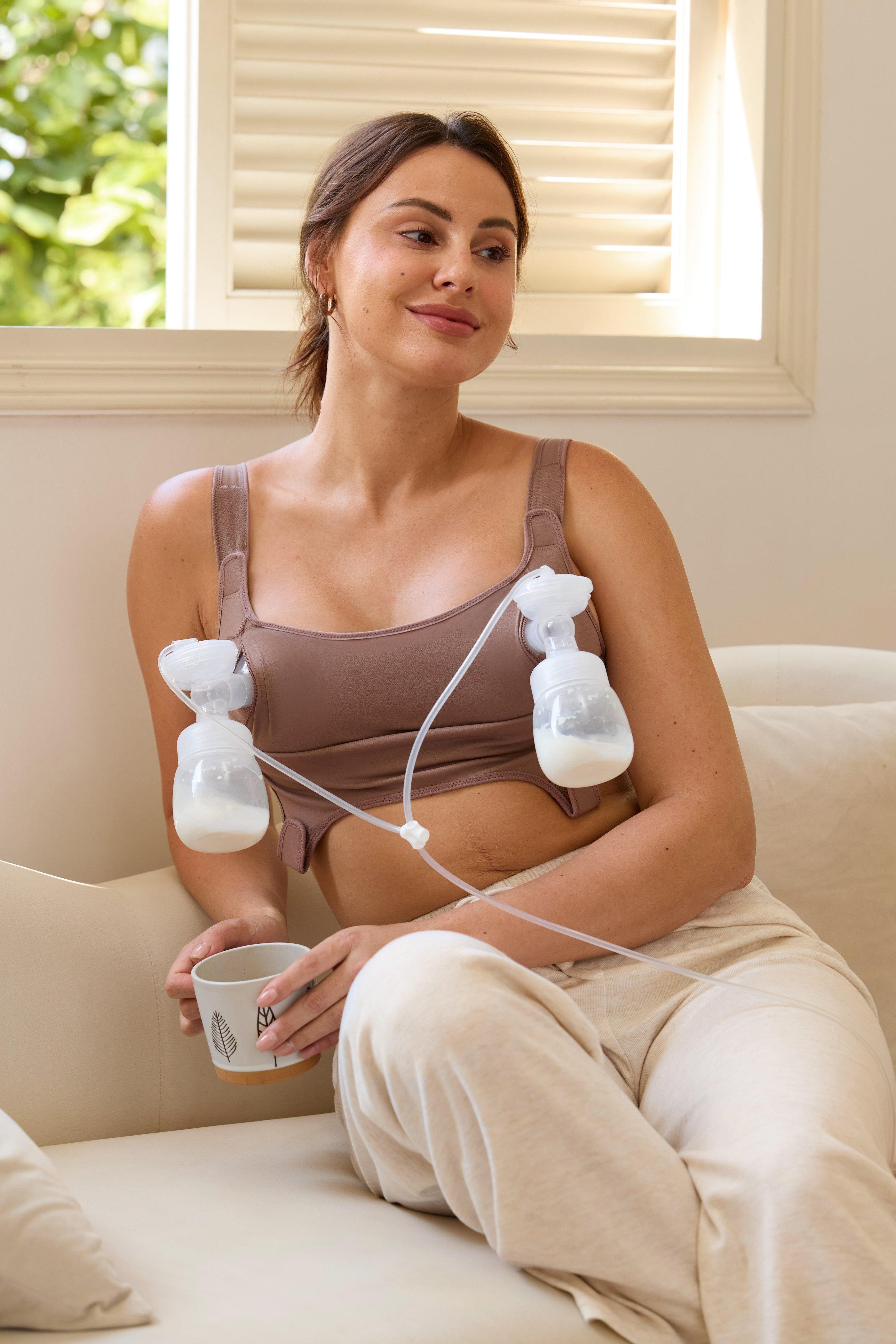How often should you pump?

As a new mom, you have a lot to learn when it comes to breastfeeding. Sometimes, it can feel like there is a right and wrong way to do everything. Which is kinda true in a way. From taking good care of your breasts to cleaning yourself to prevent infections to pumping, everything affects the quality of breast milk that your little one eventually gets. And if you want to ensure that your baby gets the best care possible, you have to be meticulous about all of it.
Pumping is one of those things that may seem pretty straightforward but is actually rather complicated, especially when you have never done it before. Lactation consultants recommend doing it by following a routine and using a specific pattern every day. This will planning, knowing what output to anticipate, and identifying any problems a lot easier for you.
Once your breast milk is collected in bottles or bags, allow your little one to feed whenever they like. However, you should still try to set a feeding routine and follow it every day. Babies thrive when there is order. They like knowing what to expect. Besides, establishing a routine right from the start with a newborn will make your like a whole lot easier as they grow.
Why do moms need to pump?
There are many reasons why a woman might need to pump. Here are some of them:
- They may have a premature baby who cannot be breastfed.
- The baby might have a medical condition that makes it hard to breastfeed
- Mom might have a medical condition that makes it hard to breastfeed
- The baby might have difficulty latching
- Mom might need to return to work or school. Pumping helps build up a stash that will come in handy even when mom is away.
- They may be a mother of multiples, such as twins or triplets
- They may be worried about milk supply. People who are worried about milk supply are usually more comfortable physically seeing how much milk the baby is taking
- Breastfeeding might be extremely painful for mom, but she may be able to tolerate pumping
- Mom may simply not want to breastfeed
- They may need to share the baby-related responsibilities with a non-breastfeeding partner
These are also the same reasons why some moms choose to pump exclusively. Whatever your reasons may be, if you choose to pump, it is essential to start as early after deliver as possible. This will not only help your little one start to learn how to bottle-feed sooner, but it’ll also help you familiarize yourself with the breast milk pumping and storage process. This knowledge will serve you for many months.
Typically, the best time to pump is after a nursing session. This ensures that any excess milk is gathered and put into better use. Pumped milk is extra breast milk that will ensure that the baby is well fed even when mom is resting. Plus, pumping also helps boost the milk supply.
To make pumping a more comfortable experience for you, consider investing in a good pumping bra. Our Lace Hands Free Pumping Bra is designed for hands-free pumping and simple, convenient access that will make your pumping experience a whole lot easier.
How Much Should You Pump?
Between 6 weeks to 6 months, babies consume about an ounce of milk an hour. Work with this average amount to help you figure out how much breast milk your little one is going to need every day.
If you are going to be away from your little one for a few hours, determine how much milk you need to leave behind for each hour you will be away plus an extra hour. Then pump and stock up on as much milk as you need.
Pumping for Newborns
How often you pump for your newborn will be different depending on your needs.
If you plan to only use the occasional bottles to supplement your baby's nursing sessions, you are only going to have to pump a few times a day. Ideally, you want to make sure you pump in the morning because that’s when you are the fullest.
If you are going to be an exclusively pumping mom, you are going to have to pump more times to keep up with the supply and demand. Ideally, if your baby feeds 8-12 times a day, plan to pump at least 8 times every day to meet that demand.
Over the first few weeks, consider pumping every two to three hours during the day. The good news is that there is no need to wake up to pump at night if you don’t want to. Getting as much rest as you need is more important. Therefore, as long as your baby is fine and you are not waking up to attend to them, focus on getting your beauty sleep.
Pumping for your newborn will also allow you the freedom to let another caregiver take care of the baby at night so you can get some rest. The milk you pump during the day will be super useful for nighttime feeding sessions. The hours of sleep you get at night will reenergize you enough to resume pumping in the morning.
Pumping for Lower Milk Supply
Dealing with low milk supply issues? Don’t worry. A lot of times, these issues will resolve themselves over the next few weeks, allowing you to achieve a normal supply before too long.
It is important to point out that milk supply also differs depending on the time of day you pump. Your supply will be different in the morning and at night. As you pump, try to experiment with differrent times to day to find the most ideal period for you.
If it takes you quite some time to fill a bottle, consider splitting the bottle between one to three pumping sessions. The good news is that pumping is one of the ways of boosting your milk supply. This means you should start to notice a steady increase in production over time if you are pumping daily.
Apart from pumping, other ways of boosting milk supply include:
- Breastfeeding your baby often
- Pumping frequently between feeds
- Latching the baby properly
- Breast stimulation exercises
- Breastfeeding or pumping from each breast equally
- Eating lactation cookies and galactagogues
- Drinking plenty of fluids and eating well
- Making healthy lifestyle choices such as relaxing and reducing your stress levels, limiting your alcohol intake, not smoking, avoiding hormonal birth control solutions, and wearing the right size bra.
For more information, read our guide on how new moms can boost their milk supply.
If none of these interventions work for your low milk supply issues, consult your doctor or your lactation consultant.
Pumping for Working Moms
If you are going back to work and planning to pump, you need to remember that it is your right to do so. Your employer is required by law to accommodate your needs. They are required to provide a private space that is not a bathroom for your pumping needs as well as allocating you a reasonable break time to spend pumping every day. Therefore, be sure to talk to HR and your boss to ensure that your workplace is a condusive environment for you.
Once you go back to work, try to pump every 3-4 hours for 15 minutes each session. This way, you will be able to meet your little one’s feeding needs even while you are away.
Consider pumping both breasts simultaneously every time. You can do this if you have a pumping bra that’s been designed to do exactly that. When you pump both your breasts at the same time, it will help improve your let-down reflex while also boothing your overal milk supply. It is also a more efficient, time-saving way of pumping in the workplace.
At the end of the day, the choice to pump or not is a deeply personal one that is yours and yours alone to make. If you opt to pump in the workplace, understand that it is your legal right and no one should pressure you into doing anything you are not comfortable with.
Final Thoughts
As you can see, how often you pump and how much milk you pump will depend on your unique set of needs. Having a good idea of how much milk your little one consumes every hour will help you plan better for when you’ll be away from them. On average, babies consume about an ounce of milk an hour from the age of 6 weeks to 6 months.
Samantha Hoare - Feb. 13 2022
Will Pumping Every 2 Hours Increase Milk Supply?
Mar 17, 2025 SamanthaHoare
How Long Is Breast Milk Good For After Pumping
Mar 12, 2025 SamanthaHoare
Does Mastitis Decrease Milk Supply?
Feb 04, 2025 SamanthaHoare
Can You Mix Breast Milk from Different Days?
Feb 04, 2025 SamanthaHoare
What Color Is Healthy Breast Milk?
Jan 12, 2025 SamanthaHoare
How to fit pumping into your busy schedule
Apr 28, 2022 AngeliaSmith
SUBCRIBE FOR NEWSLETTER
Shop today with 10% OFF your first order of all products storewide












